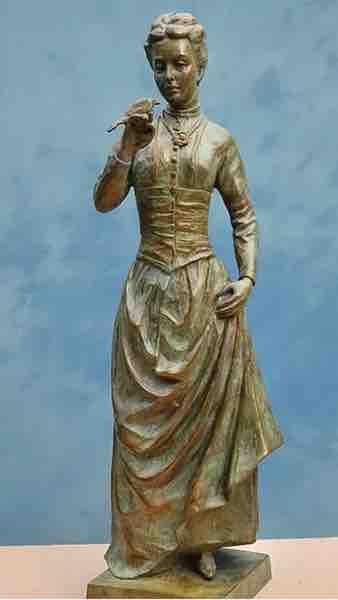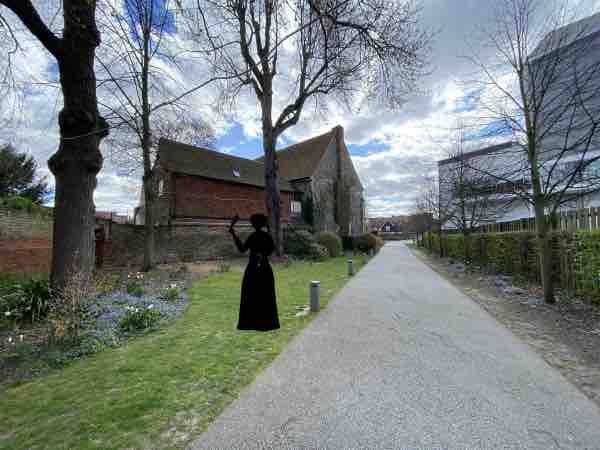|
Britain’s first professional writer: Aphra Behn. Yale Center for British Art, Yale University, New Haven, Connecticut
Much public debate has centred on what to do with many of our statues: take them down, move them to a museum, leave them be. In a recent article, Guardian journalist Gary Younge went so far as to argue the case for removing every public statue of a historical figure.
I can empathise with his argument, but I don’t think this is the solution to our current reckoning with monuments. In Europe we’ve been raising (and taking down) statues for centuries. Statues were not a 19th-century innovation, but a cultural programme that has its roots in Ancient Greece and Rome. And we are, perhaps, too invested in our own human image to stop raising them.
Statues can be useful. They allow us to look at a projected vision of an ideal “us”, but also to question the ideas and structures that support such a view. We can use statues as a tool to think and to reflect. In short, to know ourselves better.
If there is anything that events of the past year have taught us, it’s that the public has a newfound interest in statues. Take sculptor Maggi Hambling’s recently unveiled monument for 18th-century feminist writer Mary Wollstonecraft: the work divided public opinion, but it also showed the huge number of people invested in it. The work usefully opened up a broader public interest in who Wollstonecraft was, and how we might represent such an extraordinary woman.
Read more: Mary Wollstonecraft statue: a provocative tribute for a radical woman
Such debates aren’t necessary to generate interest in the contributions of the Queen Victorias and Dukes of Wellington – but there are hundreds of figures who have played pivotal roles in developing our cultural and social fabric, whose stories are little known by the public.
If we are to better understand Britain’s past, we need to start recovering those voices. Arguably, they could be the best means of balancing out public understanding of Britain’s imperial and patriarchal past with a more nuanced and marginalised story.
Statues for women
Where that pertains to histories of women, Wollstonecraft is only the tip of the iceberg. Recent weeks saw the unveiling of a statue to the suffragette Emily Davison in Epsom, who died in an act of protest at the Derby horse race in 1913. Fundraising is also underway for statues for her sister suffragettes Sylvia Pankhurst, Mary Clarke and Elizabeth Elmy.

Design for a statue for Emily Williamson, who founded the RSPB. emilywilliamsonstatue.com
These are fitting tributes to women who gave their lives for women’s rights, but were slandered in the contemporary press.
An appreciation of earlier women activists is also registered in a project to raise a memorial to the Matchgirls, whose successful strike in 1888 was key to the advance of labour rights.
Work is currently underway on a statue for the pioneer of palaeontology, Mary Anning, who discovered a complete skeleton of a plesiosaur in 1823 when she was just 12 years old. And the public can vote on a shortlist of designs for a statue to Emily Williamson, who founded the Royal Society for the Protection of Birds (RSPB) in 1889.
Raising women writers
A campaign for the first full-size statue of the writer Virginia Woolf has been given momentum by media coverage of Hambling’s Wollstonecraft memorial. Let us hope this translates into support, also, for Canterbury’s proposed statue for Aphra Behn (1640-1689), following the launch of the campaign on June 24.
You’d be forgiven for not knowing who Aphra Behn was. Scholars have been recovering her works and importance for decades now, and despite one of Behn’s plays, The Rover (1677), making it on to the A-Level syllabus, she remains little known by the general public.
Yet Behn was one of the most important writers in the entire tradition of English literature. Woolf recognised this a century ago, when she wrote that: “All women together ought to let flowers fall upon the tomb of Aphra Behn, for it was she who earned them the right to speak their minds.”
For Woolf, Behn’s importance lay in the fact that she was the first woman writer to turn professional. Today, it is clear her contribution was even greater.

A possible site for a statue of Aphra Behn would be close to Canterbury’s Marlowe Theatre, which celebrates another of the city’s great writers. A is for Aphra
Behn wrote an enormous amount across an array of genres. She penned at least 18 plays, including some of the most frequently staged works of the century that followed. She edited several collections of poetry, wrote the first English novel, Love-letters between a Nobleman and his Sister (1684-87), and authored a novella, Oroonoko (1688), that took as its tragic hero an African prince who had been sold into slavery.
Why is Behn not better known? As with many of the issues around today’s statue debates, we can blame the Victorians, who saw her as a dangerously immoral example of women’s engagement in a male craft. Behn was written out of English literary history in the 19th century, and we are still in the process of writing her back in. The Canterbury statue offers an important public step in this process.
Behn’s shifting reception as a writer reminds us of society’s changing attitudes to leading figures from the past. This is not a static relationship, but an evolving process in which we constantly need to revisit, reread and reassess.
There’s no doubt that Britain’s sculptural landscape is skewed at present to suggest a story of national progress dominated by imperial, male and white “heroes”. But what are heroes, and what does our past really look like? These are the types of questions we should ask of statues, rather than blindly accepting the narratives they were designed to convey.
Our newly re-energised relationship with statues is part of our own dialogue with the past. We should be raising statues up as well as taking them down. |


